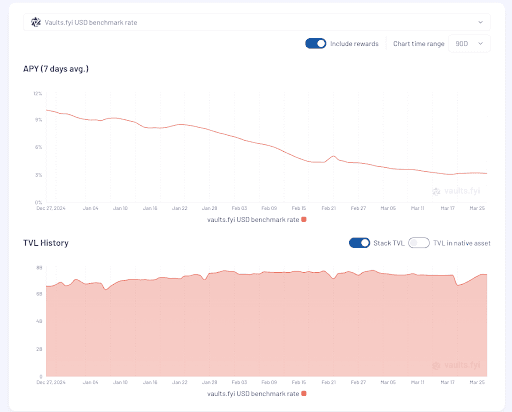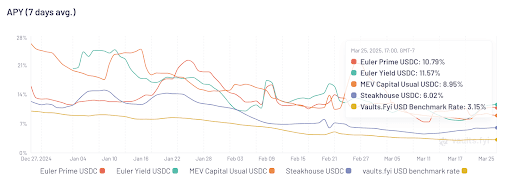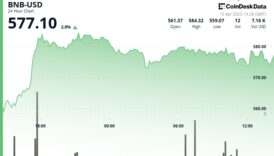Innovation Amid Yield Compression: DeFi Lending Markets in Q1 2025

The first quarter of 2025 tells a clear story about DeFi’s evolution. While yields across major lending platforms have compressed significantly, innovation at the market’s edges demonstrates DeFi’s continued maturation and growth.
The Great Yield Compression
DeFi yields have declined sharply across all major lending platforms:
- The vaults.fyi USD benchmark has fallen below 3.1%, below the U.S. 1-month T-bill yield of ~4.3% for the first time since late 2023. This benchmark, a weighted average across four leading markets, approached 14% in late 2024.
- Spark has implemented four consecutive rate decreases in 2025 alone. Starting the year at 12.5%, rates were cut to 8.75%, then 6.5%, and now sit at 4.5%.
- Aave’s stablecoin yields on mainnet are around 3% for USDC and USDT, levels that would have been considered disappointing just months ago.
This compression signals a market that’s cooled significantly from late-2024’s exuberance, with subdued borrower demand across major platforms.
The TVL Paradox: Growth Despite Lower Yields
Despite falling yields, major stablecoin vaults have experienced extraordinary growth:
- Collectively, the largest vaults on Aave, Sky, Ethena, and Compound have nearly quadrupled in size over the past 12 months, expanding from about $4 billion to about $15 billion in supply-side deposits.
- Despite Spark’s consecutive rate cuts, TVL has grown more than 3x from the start of 2025.
As yields have fallen from nearly 15% to under 5%, capital has remained sticky. This seemingly contradictory behavior reflects increasing institutional comfort with DeFi protocols as legitimate financial infrastructure rather than speculative vehicles.

The Rise of Curators: DeFi’s New Asset Managers
The emergence of curation represents a significant shift in DeFi lending. Protocols like Morpho and Euler have introduced curators who build, manage, and optimize lending vaults.
These curators serve as a new breed of DeFi asset managers, evaluating markets, setting risk parameters, and optimizing capital allocations to deliver enhanced yields. Unlike traditional service providers who merely advise protocols, curators actively manage capital deployment strategies across various lending opportunities.
On platforms like Morpho and Euler, curators handle risk management functions: selecting which assets can serve as collateral, setting appropriate loan-to-value ratios, choosing oracle price feeds, and implementing supply caps. They essentially build targeted lending strategies optimized for specific risk-reward profiles, sitting between passive lenders and sources of yield.
Firms like Gauntlet, previously service providers to protocols like Aave or Compound, now directly manage nearly $750 million in TVL across several protocols. With performance fees ranging from 0-15%, this potentially represents millions in annual revenue with significantly more upside than traditional service arrangements. Per a Morpho dashboard, curators have cumulatively generated nearly 3 million in revenue and based on Q1 revenue are on track to do 7.8mm in 2025.

The most successful curator strategies have maintained higher yields primarily by accepting higher-yielding collaterals at more aggressive LTV ratios, particularly leveraging Pendle LP tokens. This approach requires sophisticated risk management but delivers superior returns in the current compressed environment.
As concrete examples, yields on the largest USDC vaults on both Morpho and Euler have outperformed the vaults.fyi benchmark, showing 5-8% base yields and 6-12% yields inclusive of token rewards.

Protocol Stratification: A Layered Market
The compressed environment has created a distinct market structure:
1. Blue-chip Infrastructure (Aave, Compound, Sky)
- Function similar to traditional money market funds
- Offer modest yields (2.4-6.5%) with maximum security and liquidity
- Have captured the lion’s share of TVL growth
2. Infrastructure Optimizers & Strategy Providers
- Base Layer Optimizers: Platforms like Morpho and Euler provide modular infrastructure enabling greater capital efficiency
- Strategy Providers: Specialized firms like MEV Capital, Smokehouse, and Gauntlet build on these platforms to deliver higher yields upwards of 12% on USDC and USDT (as of late March)
This two-tier relationship creates a more dynamic market where strategy providers can rapidly iterate on yield opportunities without building core infrastructure. The yields ultimately available to users depend on both the efficiency of the base protocol and the sophistication of strategies deployed on top.
This restructured market means users now navigate a more complex landscape where the relationship between protocols and strategies determines yield potential. While blue-chip protocols offer simplicity and safety, the combination of optimizing protocols and specialized strategies provides yields comparable to what previously existed on platforms like Aave or Compound during higher rate environments.
Chain by Chain: Where Yields Live Now
Despite the proliferation of L2s and alternative L1s, Ethereum mainnet continues to host many of the top yield opportunities, both inclusive and exclusive of token incentives. This persistence of Ethereum’s yield advantage is notable in a market where incentive programs have often shifted yield-seeking capital to newer chains.
Among mature chains (Ethereum, Arbitrum, Base, Polygon, Optimism), yields remain depressed across the board. Outside of mainnet, most of the attractive yield opportunities are concentrated on Base, suggesting its emerging role as a secondary yield hub.
Newer chains with substantial incentive programs (like Berachain and Sonic) show elevated yields, but the sustainability of these rates remains questionable as incentives eventually taper.
The DeFi Mullet: FinTech in the Front, DeFi in the Back
A significant development this quarter was Coinbase’s introduction of Bitcoin-collateralized loans powered by Morpho on its Base network. This integration represents the emerging “DeFi Mullet” thesis – fintech interfaces in the front, DeFi infrastructure in the back.
As Coinbase’s head of Consumer Products Max Branzburg has noted: “This is a moment where we’re planting a flag that Coinbase is coming on-chain, and we’re bringing millions of users with their billions of dollars.” The integration brings Morpho’s lending capabilities directly into Coinbase’s user interface, allowing users to borrow up to $100,000 in USDC against their bitcoin holdings.
This approach embodies the view that billions will eventually use Ethereum and DeFi protocols without knowing it — just as they use TCP/IP today without awareness. Traditional FinTech companies will increasingly adopt this strategy, keeping familiar interfaces while leveraging DeFi’s infrastructure.
The Coinbase implementation is particularly notable for its full-circle integration within the Coinbase ecosystem: users post BTC collateral to mint cbBTC (Coinbase’s wrapped Bitcoin on Base) and borrow USDC (Coinbase’s stablecoin) on Morpho (a Coinbase-funded lending platform) atop Base (Coinbase’s Layer 2 network).
Looking Forward: Catalysts for the Lending Market
Several factors could reshape the lending landscape through 2025:
- Democratized curation: As curator models mature, could AI agents in crypto eventually enable everyone to become their own curator? While still early, advances in on-chain automation suggest a future where customized risk-yield optimization becomes more accessible to retail users.
- RWA integration: The continued evolution of real-world asset integration could introduce new yield sources less correlated with crypto market cycles.
- Institutional adoption: The scaling institutional comfort with DeFi infrastructure suggests growing capital flows that could alter lending dynamics.
- Specialized lending niches: The emergence of highly specialized lending markets targeting specific user needs beyond simple yield generation.
The protocols best positioned to thrive will be those that can operate efficiently across the risk spectrum, serving both conservative institutional capital and more aggressive yield-seekers, through increasingly sophisticated risk management and capital optimization strategies.





